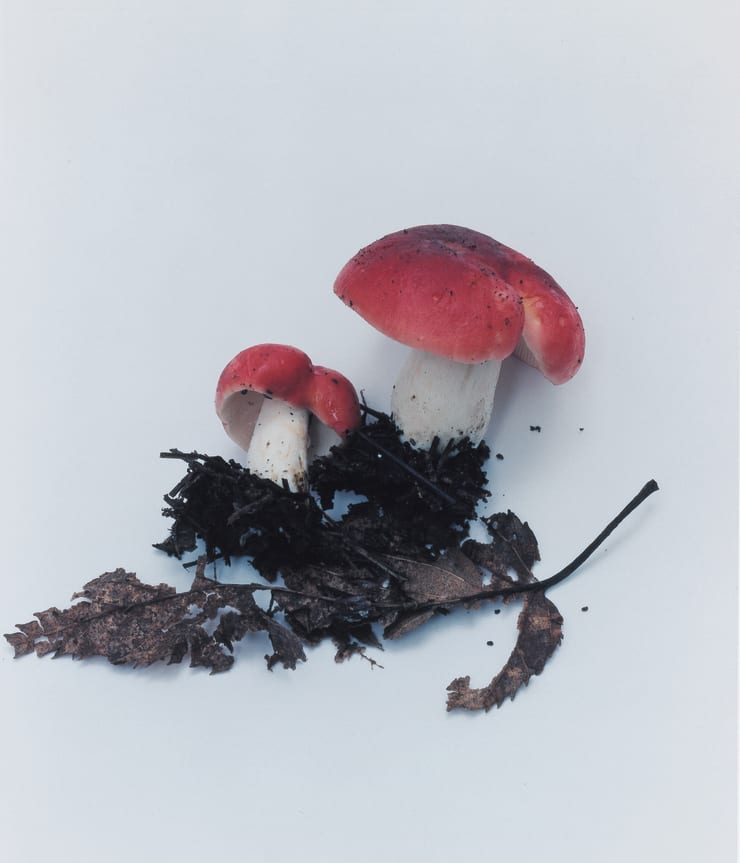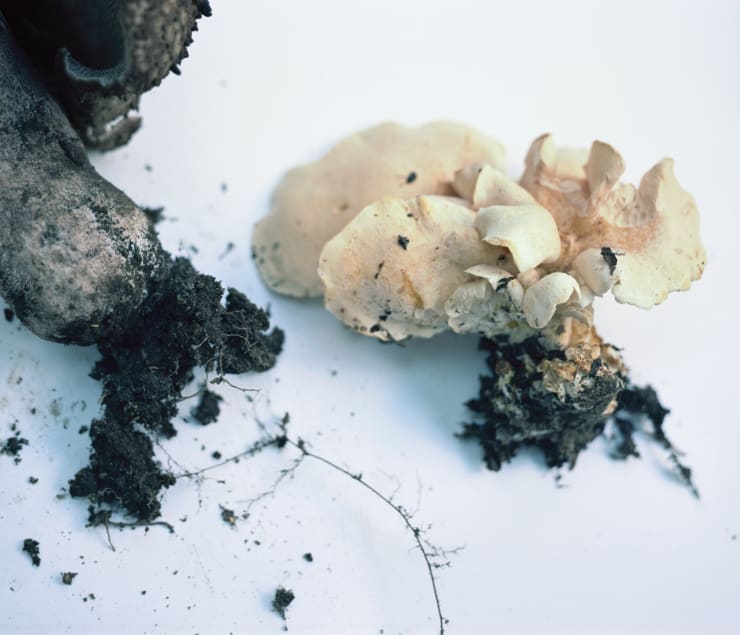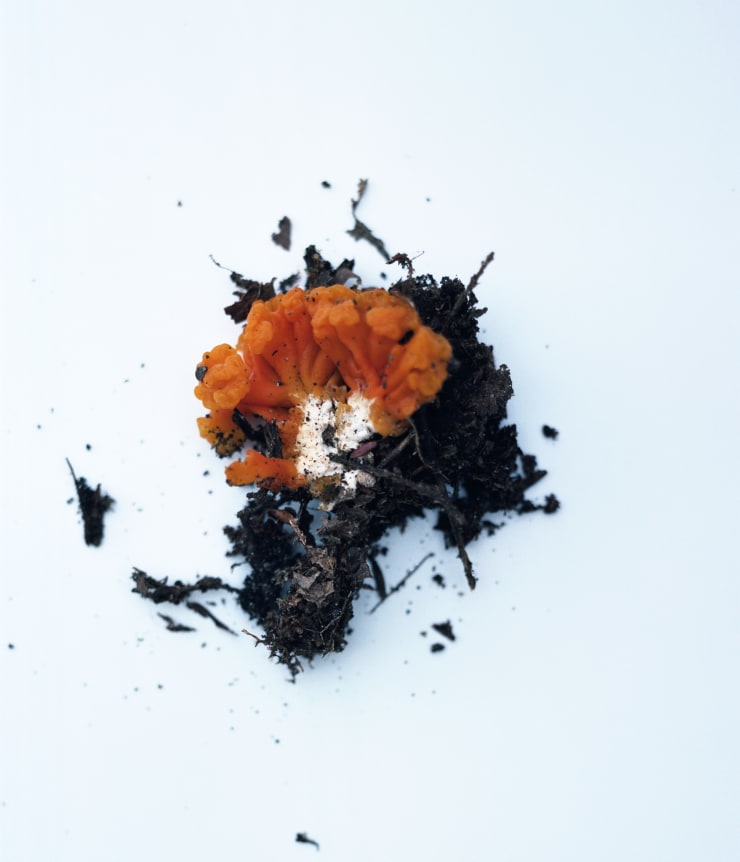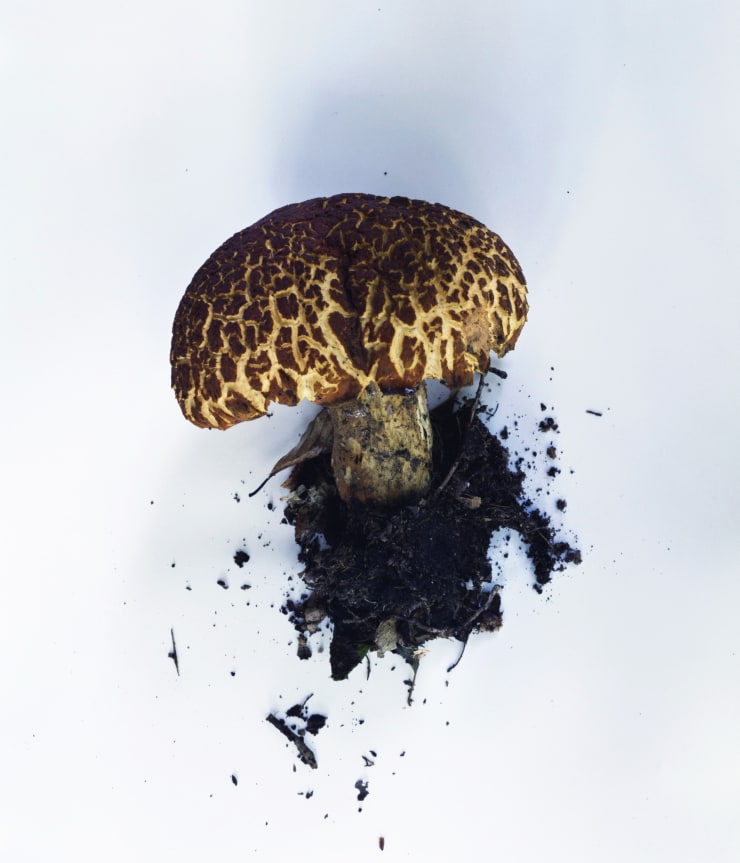Takashi Homma: mushrooms from the forest
Press:
Art Viewer, June 28, 2021
Nonaka-Hill is honored to present Takashi Homma: mushrooms from the forest, the first Los Angeles solo exhibition of works by the Japanese artist. The exhibition of thirtythree photographs is on view from June 5th to July 17th, 2021.
For this occasion, Homma selected photographs of mushrooms and the forests where he found them within contaminated zones of the Fukushima and Chernobyl nuclear disasters. Homma intermingled images of radioactive mushrooms with others from the forests in Stony Point, New York where avant-garde music composer John Cage became enamored of mushrooms and was forever changed by the study of Mycology. The series, which began in Fukushima six months after the accident, are chronicled in Homma’s monographs mushrooms from the forest (blind gallery, Tokyo, 2011) and Symphony—Mushrooms from the Forest (Case Publishing, Tokyo, 2019).
Homma’s mushroom images, which are produced onsite in the forests in “nature study style” show the specimen against white paper and are treated much like portraits. Mushrooms are the fruiting body expressions of fungi, existing as more than 1.5 million species with unique characteristics. The bulk of a mushroom’s fungi lay underground, spreading as mycelium threads to achieve elaborate networks of passageways across spectacular expanse. The communication which occurs through this network often draws comparison to our internet. Cage’s expanded concept of sound, as pertains to the mushrooms and his life the forest, most certainly takes into account the fullness of the Mushroom Kingdom, much of which is invisible and underfoot. Homma makes this visible with his inclusion of the root-systems, strains of mycelium and host soil.
The mushroom, long associated with fear, death and decay, is seen by scientists more and more as an agent of rebirth, rejuvenation and regeneration. Considered to be our distant relatives from 650,000,000 years ago, mushrooms are now employed to clean oil-spills, cure cancer and aid in mental health, and pertinent to Homma’s series, may be useful in radioactive remediation.
Born in Tokyo in 1962, Takashi Homma began his professional career in 1984, working as an inhouse photographer for a Tokyo advertising agency. In the early 1990s, Homma worked in London as a photographer for i-D maga¬zine, world renowned for its keen and enduring eye on youth culture and the diversity of human expression, often captured in “street photography”. Homma returned to Japan and, in the following years, he photographed Japan as it really exists, chronicled in his 1998 artist book, Tokyo Suburbia (Korinsha Press, Tokyo), for which he was awarded the prestigious Kimura Ihei Commemorative Photography Award in 1999. A cursory review of the spectrum of photography from Japan might give the impression that two polar positions have dominated the nation’s photographic discourse: a perceived mandate to use the camera’s inherent capability to document objective truth versus a more expressive exploration of the photographic medium’s potential, Homma’s practice offers a middle ground, between a documentary and expression, a poetic view of our world as it is. Homma has produced an extraordinary range of photo books, an artform wherein he has achieved great distinction.
-
 Takashi HommaMushroom from the forest #1, 2011C-type print33.5 x 26.5 cm (image)
Takashi HommaMushroom from the forest #1, 2011C-type print33.5 x 26.5 cm (image)
35.6 x 27.9 cm (sheet)
13 1/4 x 10 3/8 in (image)
14 1/8 x 11 in (sheet)
-
 Takashi HommaMushroom from the forest #12, 2011C-type print33.5 x 26.5 cm (image)
Takashi HommaMushroom from the forest #12, 2011C-type print33.5 x 26.5 cm (image)
35.6 x 27.9 cm (sheet)
13 1/4 x 10 3/8 in (image)
14 1/8 x 11 in (sheet)
-
 Takashi HommaChernobyl #3, 2017C-type print36 3/4 x 31 1/2 in
Takashi HommaChernobyl #3, 2017C-type print36 3/4 x 31 1/2 in
93.3 x 80 cm -
 Takashi HommaChernobyl #22, 2017C-type print36 3/4 x 31 1/2 in
Takashi HommaChernobyl #22, 2017C-type print36 3/4 x 31 1/2 in
93.3 x 80 cm -
 Takashi HommaMushroom from the forest #19, 2011C-type print33.5 x 26.5 cm (image)
Takashi HommaMushroom from the forest #19, 2011C-type print33.5 x 26.5 cm (image)
35.6 x 27.9 cm (sheet)
13 1/4 x 10 3/8 in (image)
14 1/8 x 11 in (sheet)
-
 Takashi HommaChernobyl #12, 2017C-type print36 3/4 x 31 1/2 in
Takashi HommaChernobyl #12, 2017C-type print36 3/4 x 31 1/2 in
93.3 x 80 cm -
 Takashi HommaFukushima #1, 2012C-type print31 1/2 x 39 3/8 in
Takashi HommaFukushima #1, 2012C-type print31 1/2 x 39 3/8 in
80 x 100 cm -
 Takashi HommaFukushima #26, 2012C-type print31 1/2 x 39 3/8 in
Takashi HommaFukushima #26, 2012C-type print31 1/2 x 39 3/8 in
80 x 100 cm -
 Takashi HommaMushroom from the forest #11, 2011C-type print33.5 x 26.5 cm (image)
Takashi HommaMushroom from the forest #11, 2011C-type print33.5 x 26.5 cm (image)
35.6 x 27.9 cm (sheet)
13 1/4 x 10 3/8 in (image)
14 1/8 x 11 in (sheet)
-
 Takashi HommaMushroom from the forest #15, 2011C-type print33.5 x 26.5 cm (image)
Takashi HommaMushroom from the forest #15, 2011C-type print33.5 x 26.5 cm (image)
35.6 x 27.9 cm (sheet)
13 1/4 x 10 3/8 in (image)
14 1/8 x 11 in (sheet)
-
 Takashi HommaMushroom from the forest #17, 2011C-type print33.5 x 26.5 cm (image)
Takashi HommaMushroom from the forest #17, 2011C-type print33.5 x 26.5 cm (image)
35.6 x 27.9 cm (sheet)
13 1/4 x 10 3/8 in (image)
14 1/8 x 11 in (sheet)
-
 Takashi HommaStony Point #15, 2017C-type print36 3/4 x 31 1/2 in
Takashi HommaStony Point #15, 2017C-type print36 3/4 x 31 1/2 in
93.3 x 80 cm -
 Takashi HommaMushroom from the forest #2, 2011C-type print33.5 x 26.5 cm (image)
Takashi HommaMushroom from the forest #2, 2011C-type print33.5 x 26.5 cm (image)
35.6 x 27.9 cm (sheet)
13 1/4 x 10 3/8 in (image)
14 1/8 x 11 in (sheet)
-
 Takashi HommaMushroom from the forest #16, 2011C-type print33.5 x 26.5 cm (image)
Takashi HommaMushroom from the forest #16, 2011C-type print33.5 x 26.5 cm (image)
35.6 x 27.9 cm (sheet)
13 1/4 x 10 3/8 in (image)
14 1/8 x 11 in (sheet)
-
 Takashi HommaMushroom from the forest #13, 2011C-type print33.5 x 26.5 cm (image)
Takashi HommaMushroom from the forest #13, 2011C-type print33.5 x 26.5 cm (image)
35.6 x 27.9 cm (sheet)
13 1/4 x 10 3/8 in (image)
14 1/8 x 11 in (sheet)
-
 Takashi HommaMushroom from the forest #20, 2011C-type print33.5 x 26.5 cm (image)
Takashi HommaMushroom from the forest #20, 2011C-type print33.5 x 26.5 cm (image)
35.6 x 27.9 cm (sheet)
13 1/4 x 10 3/8 in (image)
14 1/8 x 11 in (sheet)
-
 Takashi HommaScandinavia #5, 2012C-type print36 3/4 x 31 1/2 in
Takashi HommaScandinavia #5, 2012C-type print36 3/4 x 31 1/2 in
93.3 x 80 cm -
 Takashi HommaMushroom from the forest #22, 2011C-type print33.5 x 26.5 cm (image)
Takashi HommaMushroom from the forest #22, 2011C-type print33.5 x 26.5 cm (image)
35.6 x 27.9 cm (sheet)
13 1/4 x 10 3/8 in (image)
14 1/8 x 11 in (sheet)
-
 Takashi HommaMushroom from the forest #21, 2011C-type print33.5 x 26.5 cm (image)
Takashi HommaMushroom from the forest #21, 2011C-type print33.5 x 26.5 cm (image)
35.6 x 27.9 cm (sheet)
13 1/4 x 10 3/8 in (image)
14 1/8 x 11 in (sheet)
-
 Takashi HommaStony Point #14, 2018C-type print36 3/4 x 31 1/2 in
Takashi HommaStony Point #14, 2018C-type print36 3/4 x 31 1/2 in
93.3 x 80 cm -
 Takashi HommaMushroom from the forest #25, 2011C-type print33.5 x 26.5 cm (image)
Takashi HommaMushroom from the forest #25, 2011C-type print33.5 x 26.5 cm (image)
35.6 x 27.9 cm (sheet)
13 1/4 x 10 3/8 in (image)
14 1/8 x 11 in (sheet)
-
 Takashi HommaMushroom from the forest #23, 2011C-type print33.5 x 26.5 cm (image)
Takashi HommaMushroom from the forest #23, 2011C-type print33.5 x 26.5 cm (image)
35.6 x 27.9 cm (sheet)
13 1/4 x 10 3/8 in (image)
14 1/8 x 11 in (sheet)
-
 Takashi HommaScandinavia #12, 2011C-type print. Unframed.36 3/4 x 31 1/2 in
Takashi HommaScandinavia #12, 2011C-type print. Unframed.36 3/4 x 31 1/2 in
93.3 x 80 cm -
 Takashi HommaMushroom from the forest #9, 2011C-type print33.5 x 26.5 cm (image)
Takashi HommaMushroom from the forest #9, 2011C-type print33.5 x 26.5 cm (image)
35.6 x 27.9 cm (sheet)
13 1/4 x 10 3/8 in (image)
14 1/8 x 11 in (sheet)
-
 Takashi HommaStony Point #4, 2018C-type print36 3/4 x 31 1/2 in
Takashi HommaStony Point #4, 2018C-type print36 3/4 x 31 1/2 in
93.3 x 80 cm -
 Takashi HommaMushroom from the forest #5, 2011C-type print33.5 x 26.5 cm (image)
Takashi HommaMushroom from the forest #5, 2011C-type print33.5 x 26.5 cm (image)
35.6 x 27.9 cm (sheet)
13 1/4 x 10 3/8 in (image)
14 1/8 x 11 in (sheet)
-
 Takashi HommaMushroom from the forest #24, 2011C-type print33.5 x 26.5 cm (image)
Takashi HommaMushroom from the forest #24, 2011C-type print33.5 x 26.5 cm (image)
35.6 x 27.9 cm (sheet)
13 1/4 x 10 3/8 in (image)
14 1/8 x 11 in (sheet)
-
 Takashi HommaScandinavia #9, 2015C-type print36 3/4 x 31 1/2 in
Takashi HommaScandinavia #9, 2015C-type print36 3/4 x 31 1/2 in
93.3 x 80 cm -
 Takashi HommaScandinavia #22, 2012C-type print36 3/4 x 31 1/2 in
Takashi HommaScandinavia #22, 2012C-type print36 3/4 x 31 1/2 in
93.3 x 80 cm -
 Takashi HommaMushroom from the forest #14, 2011C-type print33.5 x 26.5 cm (image)
Takashi HommaMushroom from the forest #14, 2011C-type print33.5 x 26.5 cm (image)
35.6 x 27.9 cm (sheet)
13 1/4 x 10 3/8 in (image)
14 1/8 x 11 in (sheet)
-
 Takashi HommaMushroom from the forest #18, 2011C-type print33.5 x 26.5 cm (image)
Takashi HommaMushroom from the forest #18, 2011C-type print33.5 x 26.5 cm (image)
35.6 x 27.9 cm (sheet)
13 1/4 x 10 3/8 in (image)
14 1/8 x 11 in (sheet)
-
 Takashi HommaMushroom from the forest #10, 2011C-type print33.5 x 26.5 cm (image)
Takashi HommaMushroom from the forest #10, 2011C-type print33.5 x 26.5 cm (image)
35.6 x 27.9 cm (sheet)
13 1/4 x 10 3/8 in (image)
14 1/8 x 11 in (sheet)
-
 Takashi HommaScandinavia #10, 2015C-type print100 x 80 cm
Takashi HommaScandinavia #10, 2015C-type print100 x 80 cm
39 3/8 x 31 1/2 in







































































